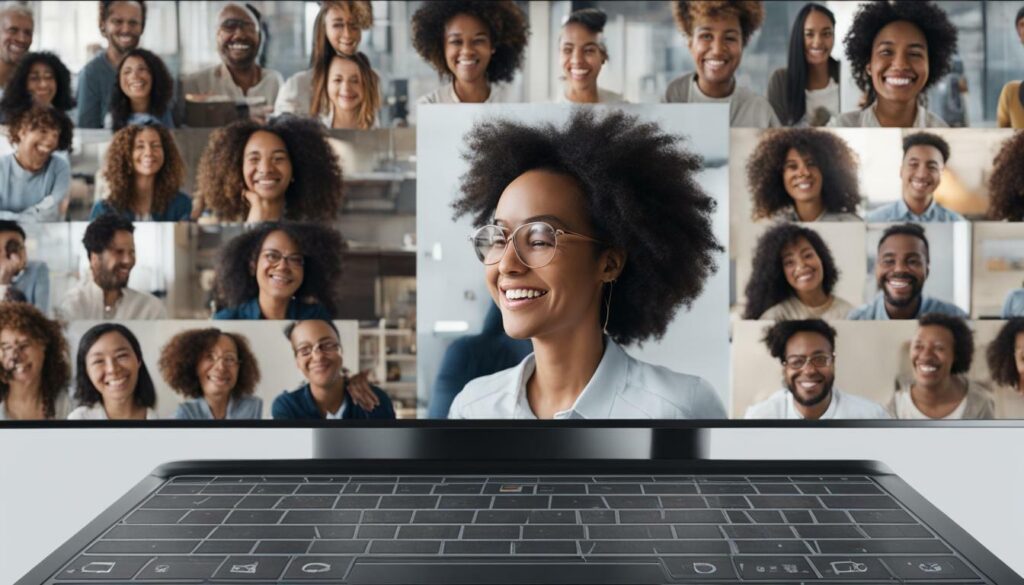Have you ever wondered whether is a virtual call a video call? Let’s find out and discover the answer together with Ringflow.
Key Takeaways:
- A virtual call is a type of phone call made over secure internet connectivity using VoIP technology.
- Virtual calls allow users to communicate with anyone on any phone number from any device.
- Ringflow is a virtual phone system that provides features like call routing and virtual receptionist.
- Virtual calls offer the convenience of accessing your own virtual office phone number from anywhere with an internet connection.
- Understanding the distinctions between virtual calls and video calls is essential for effective communication.
Understanding is a Virtual Call a Video Call
Before we can determine whether a virtual call is a video call, it’s important to understand what each term means. In today’s digital world, online communication plays a vital role in connecting individuals and businesses. Virtual calls and video calls are two commonly used methods of communication in this landscape.
A virtual call is a type of phone call that is made over secure internet connectivity using VoIP (Voice over Internet Protocol) technology. It allows users to communicate with anyone on any phone number from any device. Unlike traditional phone calls, which are routed through physical phone lines, virtual calls utilize internet-based communication networks. This enables users to easily make calls from their computers, smartphones, or other internet-connected devices.
Virtual calls offer various features and advantages compared to traditional phone calls. With platforms like Ringflow, a virtual phone system, users can access features such as call routing and virtual receptionist services. These features enhance efficiency and productivity, making virtual calls a popular choice for businesses and individuals alike.
Key Features of Virtual Calls:
| Feature | Description |
|---|---|
| Call Routing | Redirect incoming calls to specific extensions or devices. |
| Virtual Receptionist | An auto-attendant feature that provides automated greetings and calls routing options. |
| Voicemail to Email | Receive voicemail messages directly in your email inbox. |
| Call Analytics | Track call metrics and gather insights for business optimization. |
On the other hand, a video call involves real-time visual communication between two or more parties using video conferencing technology. In addition to voice communication, video calls enable participants to see each other through video feeds. This adds a personal touch to the conversation, making it a preferred choice for virtual meetings, interviews, and social interactions.
Now that we have a better understanding of virtual calls and video calls, let’s explore the distinctions between these communication methods and the specific use cases for each. Stay tuned!

What is a Virtual Call?
A virtual call is a type of phone call that is made over secure internet connectivity using VoIP technology. It allows users to communicate with anyone on any phone number from any device. Unlike traditional VoIP applications, virtual calls offer access to features like call routing and virtual receptionist. RingCentral is a virtual phone system that provides these features and allows users to access their own virtual office phone number from anywhere with an internet connection.
With virtual calls, users can make and receive calls using their internet connection, eliminating the need for traditional landlines. This means that calls can be made from anywhere, whether it’s a home office, a coffee shop, or even while travelling. The secure internet connectivity ensures that calls are encrypted and protected, providing a safe and reliable communication method.
Virtual calls also offer additional features that enhance the communication experience. Call routing allows users to direct incoming calls to different numbers or extensions, ensuring that calls are always answered by the right person. Virtual receptionist features provide automated greetings and customizable call menus, creating a professional and efficient call experience for businesses.
Benefits of Virtual Calls
Virtual calls bring several benefits to online communication and virtual communication. Some of the key advantages include:
- Flexibility: Users can make and receive calls from anywhere with an internet connection, providing flexibility and mobility.
- Cost-Effective: Virtual calls eliminate the need for traditional landlines, reducing phone bills and maintenance costs.
- Scalability: Virtual phone systems like RingCentral allow businesses to easily add or remove phone lines as needed, scaling their communication infrastructure as their organization grows.
- Advanced Features: Virtual calls offer features like call routing, virtual receptionist, and call forwarding, enhancing the communication experience and improving efficiency.
Overall, virtual calls provide a modern and convenient way to communicate, whether it’s for personal or business purposes. With the ability to make and receive calls from any device, users can stay connected and accessible no matter where they are.
| Virtual Call Features | Benefits |
|---|---|
| Call routing | Ensures calls are answered by the appropriate person |
| Virtual receptionist | Automated greetings and call menu options create a professional call experience |
| Flexibility | Make and receive calls from anywhere with an internet connection |
| Cost-effective | Saves on phone bills and maintenance costs |
| Scalability | Easily add or remove phone lines as needed |
| Advanced features | Improves communication efficiency with features like call forwarding and call recording |
By harnessing the power of virtual calls, individuals and businesses can enjoy seamless communication, enhanced productivity, and improved customer service. Whether it’s connecting with clients, collaborating with colleagues, or staying in touch with loved ones, virtual calls provide a flexible and efficient solution for all communication needs.

Advantages of Virtual Calls
Virtual calls offer several advantages over traditional phone calls, making them a popular choice for remote communication. With the rise of online communication platforms like Ringflow, individuals and businesses can now enjoy enhanced connectivity and flexibility in their communication processes.
One of the main benefits of virtual calls is their ability to transcend geographic barriers. Unlike traditional phone calls that are limited to specific phone numbers or locations, virtual calls can be made from any device with an internet connection, allowing users to connect with anyone, anywhere in the world.
Moreover, virtual calls provide access to advanced features that enhance communication efficiency. For instance, call routing allows users to direct incoming calls to the appropriate department or team member, streamlining the communication process and ensuring that calls are handled by the most suitable person.
Another advantage of virtual calls is the availability of virtual receptionist services. This feature enables businesses to automate call handling, providing callers with options to choose from and ensuring they are directed to the right department or individual. Virtual receptionists can also handle multiple calls simultaneously, eliminating the need for businesses to hire additional staff to manage high call volumes.

Virtual Call Advantages
| Advantages | Description |
|---|---|
| Global Connectivity | Virtual calls enable communication with anyone, anywhere in the world, breaking down geographic barriers. |
| Advanced Features | Features like call routing and virtual receptionist enhance communication efficiency and streamline call handling processes. |
| Flexible Accessibility | Virtual calls can be made from any device with an internet connection, providing users with flexibility and convenience. |
| Cost Savings | Virtual calls eliminate the need for traditional phone systems, reducing infrastructure and maintenance costs. |
Introducing Ringflow – Your Virtual Call Solution
Ringflow is a comprehensive platform that provides virtual call capabilities, enabling seamless virtual communication from any device. With Ringflow, users can easily connect with colleagues, clients, or friends through high-quality virtual calls, enhancing remote communication and collaboration.
One of the key features of Ringflow is its ability to offer virtual call routing. This means that incoming calls can be directed to the appropriate team member or department, ensuring efficient call handling and reducing wait times for callers. Users can also set up a virtual receptionist, allowing them to professionally greet and route incoming calls based on customizable rules and preferences.
Using Ringflow for virtual calls offers numerous advantages for businesses and individuals. It eliminates the need for expensive hardware or complicated set-ups, as all communication can be done through the Ringflow platform on any internet-connected device. Additionally, Ringflow provides a secure and reliable connection, ensuring that calls are encrypted and protected from unauthorized access.

Whether it’s for virtual meetings, conferences, client consultations, or remote collaboration, Ringflow is a powerful tool for virtual communication. Its intuitive interface and user-friendly features make it easy for anyone to set up and manage virtual calls, improving productivity and fostering effective communication.
Ringflow Virtual Call Solution Features:
| Feature | Description |
|---|---|
| Virtual call routing | Efficiently route incoming calls to the appropriate team member or department |
| Virtual receptionist | Customize call greetings and routing based on specific rules and preferences |
| High-quality audio and video | Enjoy crystal-clear audio and video during virtual calls |
| Secure and encrypted | Ensure the privacy and security of your virtual calls with encryption technology |
| Accessible from any device | Connect with others using any internet-connected device, such as a smartphone, tablet, or computer |
With Ringflow’s virtual call capabilities, users can experience the benefits of seamless virtual communication, enabling them to stay connected and collaborate from anywhere. Embrace the future of digital communication with Ringflow and unlock the full potential of virtual calls for your business or personal needs.
What is a Video Call?
A video call is a form of online communication that allows users to connect and see each other in real time using video and audio. It enables individuals and groups to have face-to-face conversations, no matter the physical distance between them. With the advancement of technology and the widespread availability of high-speed internet connections, video calls have become an essential tool for online communication, both for personal and professional purposes.
Video calls offer a level of interaction and engagement that goes beyond traditional phone calls or text-based communication. They allow participants to read facial expressions, body language, and visual cues, enhancing the overall communication experience. Whether it’s a business meeting, a catch-up with friends and family, or a remote job interview, video calls provide a more personal and immersive way to connect and collaborate.
One popular platform that facilitates video calls is Ringflow. As a virtual communication solution, Ringflow offers seamless video conferencing capabilities, enabling users to host meetings, conduct presentations, and collaborate visually in real-time. With its user-friendly interface and robust features, Ringflow provides a reliable and efficient platform for individuals and businesses to connect and communicate effectively.

Advantages of Video Calls
There are several advantages to using video calls in online communication. Firstly, it allows for increased connectivity, enabling people to stay connected with their loved ones, colleagues, and clients regardless of geographical location. This is especially valuable for remote teams, enabling them to maintain a sense of camaraderie and collaboration.
Secondly, video calls foster more effective communication by providing visual cues and non-verbal communication. When we can see each other’s facial expressions, gestures, and body language, we can better understand the tone and intent of the conversation. This helps to avoid miscommunication and ensures that messages are conveyed accurately.
Additionally, video calls save time and resources that would otherwise be spent on travel. Whether it’s for a business meeting or a medical consultation, video calls eliminate the need for physical travel, making communication more efficient and cost-effective. It also reduces the carbon footprint associated with travel, contributing to a more sustainable future.
| Advantages of Video Calls | Advantages of Virtual Calls |
|---|---|
| Increased connectivity | Flexible communication from any device |
| Enhanced communication through visual cues | Access to advanced features like call routing |
| Time and cost savings | Seamless integration with virtual office phone numbers |
Key Distinctions between Virtual Calls and Video Calls
While virtual calls and video calls both fall under the umbrella of online communication, there are important distinctions that set them apart. Virtual calls, also known as VoIP (Voice over Internet Protocol) calls, are made over secure internet connectivity using advanced technology. They allow users to communicate with anyone on any phone number from any device, providing flexibility and convenience. Virtual calls offer features like call routing and virtual receptionist, which are not commonly found in traditional phone systems. An example of a platform that provides these features is Ringflow, a virtual phone system that gives users access to their own virtual office phone number from anywhere with an internet connection.
On the other hand, video calls are a specific type of virtual call that incorporates video streaming alongside audio communication. Video calls enable face-to-face interaction and visual cues, making them ideal for scenarios where non-verbal communication is important. Platforms like video conferencing software offer additional features such as screen sharing and collaborative tools, enhancing the overall meeting experience. While virtual calls focus primarily on voice communication, video calls add a visual element that enriches the interaction.
Comparison of Virtual Calls and Video Calls
| Virtual Calls | Video Calls |
|---|---|
| Primarily voice communication | Combines audio and video communication |
| Offers call routing and virtual receptionist features | Enables face-to-face interaction and visual cues |
| Can be used with any phone number and device | Requires devices with video streaming capabilities |
Choosing between virtual calls and video calls depends on the specific needs and preferences of the users. Virtual calls are suitable for scenarios where voice communication is sufficient, such as audio conferences or phone conversations. On the other hand, video calls are ideal for situations where visual communication and non-verbal cues are important, such as video conferences or virtual meetings. Some users may find that a combination of both virtual calls and video calls offers the most comprehensive communication experience.

In conclusion, understanding the distinctions between virtual calls and video calls is crucial for choosing the right communication method for various scenarios. While virtual calls focus on voice communication and offer features like call routing, video calls incorporate visual elements and enable face-to-face interaction. Platforms like Ringflow provide the flexibility and functionality to enhance online communication through virtual calls and video calls, ensuring seamless connectivity in today’s digital world.
Use Cases for Virtual Calls
Virtual calls have versatile applications, from virtual meetings and collaborations to virtual conversations and networking. With the increasing popularity of remote work and the need for flexible communication solutions, virtual calls provide a convenient way to connect with colleagues, clients, and partners from anywhere in the world.
One use case for virtual calls is virtual meetings. Instead of gathering in a physical location, teams can utilize virtual meeting platforms to conduct meetings online. This allows for real-time communication, screen sharing, and collaboration, making it easier to work together on projects regardless of geographical barriers.

| Use Cases for Virtual Calls | Benefits |
|---|---|
| Virtual collaboration | Facilitates teamwork and project management |
| Virtual conversations | Enables instant communication and information exchange |
| Virtual networking | Allows professionals to connect and build relationships |
Another practical use for virtual calls is virtual collaboration. Whether it’s brainstorming ideas, reviewing documents, or giving presentations, virtual collaboration platforms enable teams to work together remotely. This fosters effective communication and ensures that everyone is on the same page, even if they are not physically in the same location.
Virtual calls also support virtual conversations, enabling instant communication and information exchange. Whether it’s a quick chat with a colleague or a detailed discussion with a client, virtual calls provide a seamless way to connect and share ideas in real time. This enhances productivity and ensures that important information is communicated efficiently.
Furthermore, virtual calls offer opportunities for virtual networking. Professionals can connect with industry peers, attend virtual conferences, and participate in virtual networking events. This allows for expanding professional networks, discovering new opportunities, and fostering professional growth.
- Virtual calls have versatile applications, including virtual meetings, collaborations, conversations, and networking.
- Virtual calls support remote work and enable real-time communication and collaboration.
- Virtual calls facilitate teamwork, information exchange, and relationship building.
As businesses continue to embrace remote work and flexible communication, virtual calls are becoming an essential tool for staying connected and productive. Platforms like Ringflow offer a comprehensive solution for virtual calls, providing the features and capabilities needed for effective online communication.
Use Cases for Video Calls
Video calls have become an indispensable tool for conducting virtual meetings and facilitating face-to-face interactions, even when participants are geographically dispersed. With the advancement of technology, online communication has become more accessible and convenient than ever before. Video conferencing platforms like Ringflow have made it possible for individuals and businesses to connect seamlessly, improving collaboration and productivity.
One of the key use cases for video calls is in the realm of virtual meetings. Whether it’s a team huddle, a client presentation, or a board meeting, video calls allow participants to communicate in real-time, enabling them to share ideas, documents, and visuals effortlessly. This not only saves time and travel costs but also creates a more engaging and interactive meeting experience.
Additionally, video calls are increasingly being used in virtual conferences, seminars, and workshops. These events bring together people from different locations, allowing them to join sessions, participate in discussions, and network with industry peers. Virtual conferences provide a platform for knowledge sharing and professional development, eliminating the need for physical attendance while still delivering valuable content.
Another important use case for video calls is in virtual classrooms and online education. With the global shift towards remote learning, video conferencing has become an essential tool for teachers and students. It enables teachers to deliver lectures, conduct interactive sessions, and provide personalized support to students, irrespective of their location. Video calls in education have opened up new opportunities for learning, making education more accessible and inclusive.

In conclusion, video calls have revolutionized online communication, providing a seamless and immersive experience for virtual meetings, conferences, and education. With platforms like Ringflow, individuals and businesses can leverage the power of video calls to bridge the gap between physical distance and connect with others in a meaningful way.
Combining Virtual Calls and Video Calls for Enhanced Communication
By leveraging the capabilities of both virtual calls and video calls, businesses and individuals can enhance their online communication experience. Virtual calls, such as those offered by Ringflow, provide a secure and efficient way to communicate over the internet using VoIP technology.
With virtual calls, users have access to features like call routing and virtual receptionist, allowing them to easily manage and direct calls to the appropriate recipient. This ensures that important calls are not missed and enables seamless communication within remote teams.
On the other hand, video calls bring a visual element to online communication, allowing participants to see and interact with each other in real-time. This can be particularly beneficial for meetings, presentations, and collaboration sessions where non-verbal cues and visual aids play a crucial role.
To illustrate the potential of combining virtual calls and video calls, consider a scenario where a team is working on a project remotely. They can use virtual calls to discuss and coordinate tasks, utilizing features like call routing to ensure that each team member is easily accessible. When it comes to more complex discussions or visual presentations, they can switch to video calls to enhance their communication with screen sharing and real-time video conferencing.
Benefits of Combining Virtual Calls and Video Calls:
- Increased versatility in communication methods
- Efficient call management and routing
- Improved collaboration through visual elements
- Enhanced engagement and understanding with video conferencing

By utilizing both virtual calls and video calls, businesses and individuals can optimize their online communication strategies and adapt to various scenarios. Whether it’s a quick conversation or a detailed presentation, the combination of these two communication methods provides flexibility, efficiency, and a more immersive experience.
As technology continues to evolve, it’s essential to embrace tools like Ringflow that offer virtual call and video call capabilities. This enables us to stay connected, collaborate effectively, and achieve seamless communication in the digital age.
| Benefits of Combining Virtual Calls and Video Calls | Benefits of Virtual Calls | Benefits of Video Calls |
|---|---|---|
| Increased versatility in communication methods | Easy call management and routing | Visual elements enhance collaboration |
| Efficient call management and routing | Access to features like call routing and virtual receptionist | Real-time engagement and understanding |
| Improved collaboration through visual elements | Effective communication within remote teams | Enables non-verbal cues and visual aids |
Choosing the Right Communication Method for Your Needs
Selecting the right communication method is crucial to ensure efficient and effective online interactions. With various options available, such as virtual calls and video calls, it’s important to understand the distinctions and choose the method that best suits your specific needs and preferences.
A virtual call, also known as a VoIP call, is a type of phone call that utilizes secure internet connectivity. Unlike traditional phone calls, virtual calls offer a range of features, including call routing and virtual receptionist services. With platforms like Ringflow, users can access their own virtual office phone number from any device with an internet connection. This enables seamless communication with anyone, regardless of their phone number or location.
On the other hand, video calls provide a more visual and immersive communication experience. They allow participants to see each other in real-time, making them ideal for virtual meetings, presentations, and collaboration. Platforms like Ringflow also offer video call capabilities, ensuring that users have the flexibility to choose the most suitable communication method for each interaction.
When deciding between virtual calls and video calls, consider the nature of your communication. If you primarily need to exchange information verbally, a virtual call may be sufficient. However, if visuals and non-verbal cues are crucial to your communication, a video call would be more appropriate. Additionally, consider the level of engagement and collaboration required, as video calls provide a more interactive experience.
Comparison of Virtual Calls and Video Calls
| Communication Method | Advantages | Use Cases |
|---|---|---|
| Virtual Calls | Flexible, secure, and feature-rich communication | Business calls, customer support, remote team collaboration |
| Video Calls | Enhanced visual and non-verbal communication | Virtual meetings, presentations, interviews, training |
By understanding the distinctions and advantages of virtual calls and video calls, you can make an informed decision based on your specific communication requirements. Whether it’s a virtual call for convenient and feature-rich communication or a video call for a more immersive and engaging experience, platforms like Ringflow provide the necessary tools to facilitate seamless online interactions.

Remember, effective communication is the key to successful collaboration and connectivity in the digital age. It’s essential to stay informed about the available communication methods and embrace the right tools for your needs to ensure productivity and efficiency in your online interactions.
Embracing the Future of Digital Communication with Ringflow
As technology continues to advance, it’s essential to embrace innovative platforms like Ringflow to adapt to the evolving landscape of digital communication. Ringflow is a cutting-edge virtual call solution that revolutionizes online communication, providing users with seamless connectivity and advanced features.
With Ringflow, you can harness the power of virtual calls, enabling you to communicate with anyone, anywhere, and on any device. Say goodbye to the limitations of traditional phone calls and embrace the flexibility of secure internet connectivity. Whether you’re working remotely, collaborating with a team, or simply catching up with loved ones, Ringflow ensures you stay connected effortlessly.
One of the standout features of Ringflow is its ability to provide users with a virtual office phone number. This means you can have a professional presence no matter where you are located. You can route your calls seamlessly, set up a virtual receptionist, and access a host of other helpful features that enhance your communication experience.
| Ringflow Features | Benefits |
|---|---|
| Virtual office phone number | Professional presence |
| Call routing | Efficient call management |
| Virtual receptionist | Improved customer experience |
| Seamless connectivity | Stay connected anytime, anywhere |
| Advanced call features | Enhanced communication capabilities |
With Ringflow, you can experience the future of digital communication. Whether you’re a business professional, an entrepreneur, or an individual seeking efficient and reliable connectivity, Ringflow brings you the tools you need to communicate effectively in the modern world. Embrace the power of Ringflow and unlock a world of possibilities.

In Conclusion
Understanding the differences between virtual calls and video calls is crucial in today’s digital era, and platforms like Ringflow provide the necessary tools for effective and seamless online communication. A virtual call, as we explored in this article, is a type of phone call that is made over secure internet connectivity using VoIP technology. It allows users to communicate with anyone on any phone number from any device.
Unlike traditional VoIP applications, virtual calls offer access to features like call routing and virtual receptionist. This means that users can have their own virtual office phone number that they can access from anywhere with an internet connection. With Ringflow, businesses and individuals can enjoy the benefits of virtual calls, such as improved flexibility and scalability, without compromising on call quality or security.
Furthermore, virtual calls provide a cost-effective solution for online communication, eliminating the need for traditional phone lines and reducing long-distance calling expenses. With Ringflow’s virtual call capabilities, users can easily connect with clients, colleagues, and friends worldwide, fostering collaboration and maintaining personal and professional relationships regardless of geographical boundaries.
In addition to virtual calls, Ringflow also offers video call capabilities, enabling face-to-face communication and enhancing the overall online communication experience. With the power of video conferencing, users can have virtual meetings, collaborate in real-time, and engage in virtual networking events. By combining virtual calls and video calls, users can achieve enhanced communication that is tailored to their specific needs.
As we embrace the future of digital communication, platforms like Ringflow play a significant role in keeping us connected and productive. Whether it’s a virtual call or a video call, Ringflow provides the tools and features necessary for efficient and reliable online communication. So, take advantage of the advanced capabilities offered by Ringflow and stay connected in this increasingly interconnected world.





![Canada Phone Number Example [With Country Code]](https://www.ringflow.com/wp-content/uploads/2024/04/Add-a-heading-75-1.webp)


